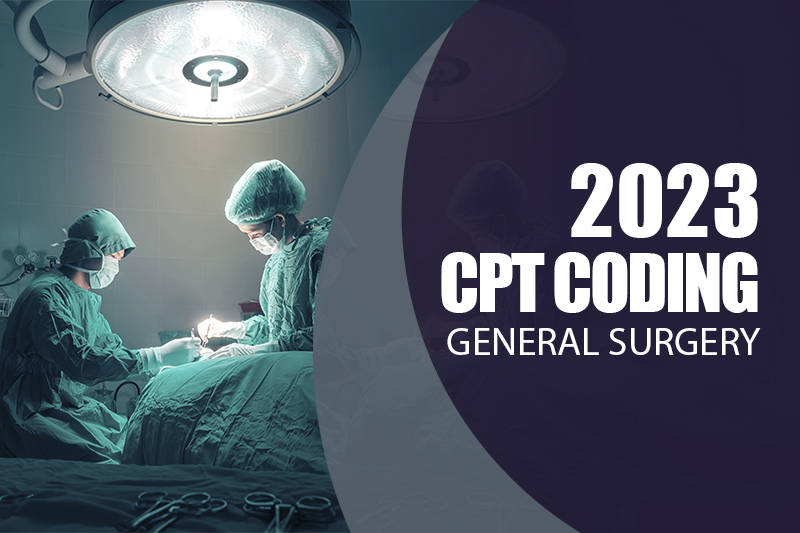General surgery comprises a wide range of surgical procedures involving the gastrointestinal tract, liver, pancreas, gallbladder, breast, skin, soft tissue, and endocrine system. This medical speciality includes many sub-specialties that focus on specific areas or types of surgeries, making it a diverse and complex one. As billing and coding for general surgery comes with several challenges, surgeons often require expert support to report their services. In 2023, there are many CPT code updates for general surgery and its specialties. Partnering with an experienced general surgery medical billing company can help providers ensure accurate billing and coding.
Maximize your revenue and minimize denials with our reliable medical coding services – contact us now!
2023 CPT Code Updates for General Surgery and Related Specialties
In 2023, general surgery has new and revised codes as well as code deletions. Here, we take a look at the updates for 7 key modalities:
Anterior Abdominal Hernia Repair
There are many changes to the hernia repair codes for epigastric, incisional, ventral, umbilical, and spigelian abdominal hernias.
- Deleted codes : codes 49560-49590 (open repair of anterior abdominal hernias); 49652-49657 (laparoscopic repair of anterior abdominal hernias) and add-on code 49568 (implantation of mesh for open ventral/incisional hernias and defects due to necrotizing soft tissue infection).
- 15 new codes with addition of introductory guidelines and parentheticals: 12 new codes (49591-49596 and 49613-49618) to report anterior abdominal hernia repair by any approach (i.e., open, laparoscopic, robotic), further by initial or recurrent hernia, further by total defect size, and further by reducible or incarcerated/strangulated; 2 new codes (49621-49622) to report parastomal hernia repair by any approach (i.e., open, laparoscopic, robotic), further divided by reducible or incarcerated/strangulated; 1 new add-on code (49623) for removal of mesh/prosthesis at the time of initial or recurrent anterior abdominal hernia repair or parastomal hernia repair (code 49623 can only be reported with codes 49591-49622).
- Code selection should be based on size or total length of the hernia defect, type of hernia (initial versus recurrent), and severity (reducible or incarcerated/strangulated). If there are multiple hernias, the entire repair defaults to the highest severity of any of the defects (ACS).
- Global period – The new anterior abdominal hernia repair codes have a 0-day global assignment. All subsequent procedures and services performed starting the day after the operation need to be separately reported. For e.g., additional procedures such as wound debridement, suture/staple removal are separately reportable even if not done in the OR.
Implantation of Mesh for Delayed Closure
- Deleted: Add-on code 49658 for mesh placement for open hernia repair or for closure of wounds from necrotizing soft tissue infection has been deleted.
- Mesh placement included: All new anterior abdominal hernia repair codes include mesh placement.
- New code 15778 under the range – Other Flaps and Grafts Procedures: Code 15778 ( Implantation of absorbable mesh or other prosthesis for delayed closure of defect(s) (i.e., external genitalia, perineum, abdominal wall) due to soft tissue infection or trauma ). Consider 15778 with Fournier’s Gangrene Debridement + Mesh (www.aapc.com).
Removal of Sutures and/or Staples “In the Office” / Under Anesthesia
- Code 15850 deleted: Code 15850 Removal of sutures under anesthesia has been deleted with a parenthetical reference added to report code 15851.
- CPT codes 15851 and 15852 are used to report suture removal and dressing change, respectively, under anesthesia other than local anesthesia.
These codes should not be reported when a patient requires anesthesia for a related procedure (such as return to the operating room for removal of sutures and redressing to reopen an incision for treatment of complications). Also, do not report CPT code 15852 with a primary procedure (aapc.com).
-
- Revised: Code 15851 has been revised to include ‘sutures or staples’ requiring anesthesia (general anesthesia or moderate sedation), and no longer includes ‘Other Surgeon’ in its descriptor.
- 2 new add-on codes to capture suture and/or staple removal at the time of an E/M visit:
15853 Removal of sutures or staples not requiring anesthesia (List separately in addition to E/M code)
15854 Removal of sutures and staples not requiring anesthesia (List separately in addition to E/M code)
Codes 15853 and 15854 may be reported multiple times, but only once per day. Also, as they are add-on codes to be reported with an E/M code, no modifier should be appended to the E/M code.
Percutaneous Arteriovenous (AV) Fistula
-
- 2 new codes: There are 2 new codes to report percutaneous arteriovenous fistula creation in the upper extremity via a single access of both the peripheral artery and peripheral vein.
Note : Use unlisted vascular surgery procedure code 37799 to report percutaneous AV fistula creation in any location other than the upper extremity.
Intragastric Bariatric Balloon
-
- 2 new endoscopic bariatric treatment codes to report esophagogastroduodenoscopy (EGD) deployment and removal of a bariatric balloon device:
43290 EGD, flexible, transoral; with deployment of intragastric bariatric balloon
43291 EGD, flexible, transoral; with removal of intragastric bariatric balloon(s).
Lap Prostatectomy
There is a new code to report a laparoscopic simple prostatectomy, a minimally-invasive approach for benign prostatic hyperplasia:
- 55867 Laparoscopy, surgical prostatectomy, simple subtotal (including control of postoperative bleeding, vasectomy, meatotomy, urethral calibration and/or dilation, and internal urethrotomy), includes robotic assistance, when performed ).
New Modifier 93 Synchronous Audio-Only Telemedicine
- Modifier 93 Synchronous Audio-Only Telemedicine Rendered Via Telephone or Other Real-Time Interactive Audio-Only Telecommunications System
CPT defines synchronous telemedicine service as “a real-time interaction between a physician or other qualified health care professional and a patient who is located away at a distant site from the physician or other qualified health care professional”.
Note : The entire communication of information exchanged between the physician or other qualified health care professional and the patient during the synchronous telemedicine service must be of an amount and nature that is sufficient to meet the key components and/or requirements of the same service when rendered via a face-to-face interaction.
Outsource your medical billing and coding to us – stay compliant, avoid penalties, and ensure timely and appropriate reimbursement!
Ensure Accurate Billing and Coding — Partner with an Expert
With a wide range of routine to the profoundly complicated procedures and services, general surgery medical billing and coding is complex. New codes and guidelines make things even more challenging. Partnering with an experienced provider of medical coding services is a practical way for general surgeons to ensure accurate coding and billing, minimize claim denials and payment delays, and maximize reimbursement.





